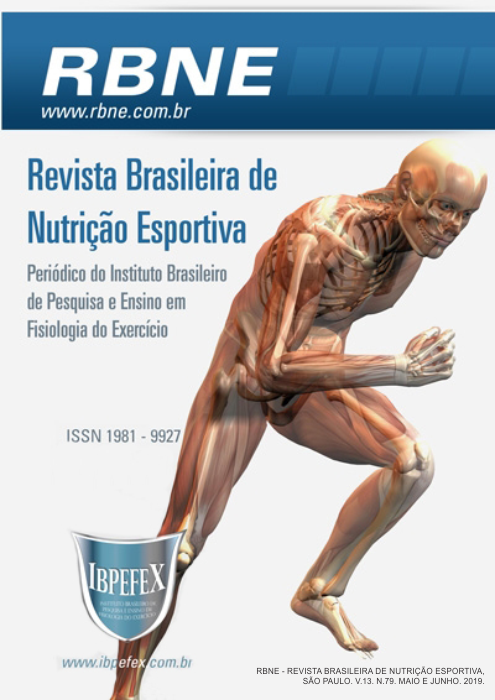Prevalence of lactose intolerance (by self-report) in adults and their dietary adaptations
Abstract
Lactose intolerance occurs when individuals who have an inefficient lactose digestion manifest symptom such as colic, pain, bloating or diarrhea when consuming milk and / or milk products. In North American countries, the prevalence of self-reported lactose intolerance is between 11% and 16%. Similar data for Brazil is not available. Objective: To evaluate the prevalence of lactose intolerance in the adult population by self-report and to examine their dietary adaptations. Method: cross-sectional study with individuals, randomly selected, invited to answer a questionnaire. Results: The overall prevalence of self-reported lactose intolerance was 32.3% (n = 67). Of the total sample of individuals considered to be lactose intolerant, 92.5% (n = 62) were women and 7.5% (n = 5) were men. Most (97%) reduce or eliminate dairy products from their eating routine and less than 3% do not make this change. Conclusion: The prevalence of self-reported lactose intolerance was considerably higher than that reported in other studies, almost 1 in 3 Brazilian adults believe to be lactose intolerant, and many have limited their intake of milk and dairy products. It is important that health professionals advise individuals with self-reporting or diagnosis about an appropriate food intake to avoid nutritional deficiencies.
References
-Barr, S.I. Perceived lactose intolerance in adult Canadians: a national survey. Appl. Physiol. Nutr. Metab. Vol. 38. p. 830-835. 2013.
-Bolland, M.J.; Avenell, A.; Baron, J.A.; Grey, A.; MacLennan, G.S. Effect of calcium supplements on risk of myocardial infarction and cardiovascular events: meta-analysis. BMJ. Vol. 341. p. c3691. 2010.
-Fisher, R.; US Department of Health and Human Services, National Institutes of Health, National Institute of Diabetes and Digestive and Kidney Diseases. Lactose intolerance. NIH Publication no. 09-2751. 2009.
-Heaney, R.P.; Kopecky, S.; Maki, K.C.; Hathcock, J.; MacKay, D. A review of calcium supplements and cardiovascular disease risk. Adv. Nutr. Vol.3. Num. 6. p. 763-771. 2012.
-Heaney, R.P. Dairy and bone health. J. Am. Coll. Nutr. Vol. 28. Suppl. 1. p. 82S-90S. 2009.
-Keith, J.N.; Nicholls, J.; Reed, A.; Kafer, K.; Miller, G.D. The Prevalence of Self-reported Lactose Intolerance and the Consumption of Dairy Foods Among African American Adults Are Less Than Expected. J Natl Med Assoc. Vol. 103. p. 36-45. 2011.
-Larsson, S.C.; Bergkvist, L.; Rutegård, J.; Giovannucci, E.; Wolk, A. Calcium and dairy food intakes are inversely associated with colorectal cancer risk in the cohort of Swedish men. Am. J. Clin. Nutr. Vol. 83. Num. 3. p. 667-673. 2006.
-Lovelace, H.Y.; Barr, S.I. Diagnosis, symptoms, and calcium intakes of individuals with self-reported lactose intolerance. J. Am. Coll. Nutr. Vol. 24. Num. 1. p. 51-57. 2005.
-Nicklas, T.A.; Qu, H.; Hughes, S.O.; He, M.; Wagner, S.E. Self-perceived lactose intolerance results in lower intakes of calcium and dairy foods and is associated with hypertension and diabetes in adults. Am J ClinNutr. Vol. 94. p. 191-198. 2011.
-Park, S.Y.; Murphy, S.P.; Wilkens, L.R.; Nomura, A.H.Y.; Henderson, B.E. Calcium and vitamin D intake and risk of colorectal cancer: the Multiethnic Cohort Study. Am. J. Epidemiol. Vol. 165. Num. 7. p. 784-793. 2007.
-Ralston, R.A.; Lee, J.H.; Truby, H.; Palermo, C.E.; Walker, K.Z. A systematic review and meta-analysis of elevated blood pressure and consumption of dairy foods. J. Hum. Hypertens. Vol. 26. Num. 1. p. 3-13. 2012.
-Samelson, E.J.; Booth, S.L.; Fox, C.S.; Tucker, K.L.; Wang, T.J. Calcium intake is not associated with increased coronary artery calcification: the Framingham Study. Am. J. Clin. Nutr. Vol. 96. Num. 6. p. 1274-1280. 2012.
-Savaiano, D.A.; Boushey, C.J.; McCabe, G.P. Lactose intolerance symptoms assessed by meta-analysis: a grain of truth that leads to exaggeration. J. Nutr. Vol. 136. Num. 4. p. 1107-1113. 2006.
-Savaiano, D.A.; Ritter, A.J.; Klaenhammer, T.R.; James, G.M.; Longcore, A.T. Improving lactose digestion and symptoms of lactose intolerance with a novel galacto-oligosaccharide (RP-G28): a randomized, double-blind clinical trial. Nutrition Journal. Vol. 12. p. 160. 2013.
-Shaukat, A.; Levitt, M.D.; Taylor, B.C.; MacDonald, R.; Shamliyan, T.A. Systematic review: effective management strategies for lactose intolerance. Ann. Int. Med. Vol. 152. Num. 12. p. 797-803. 2010.
-Suchy, F.J.; Brannon, P.M.; Carpenter, T.O.NIH Consensus Development Conference Statement: lactose intolerance and health. NIH Consens State Sci Statements. Vol. 27. p. 1-27. 2010.
-Vesa, T.H.; Marteau, P.; Korpela, R. Lactose intolerance. J. Am. Coll. Nutr. Vol. 19. p. 165S-175S. 2000.
-Xiao, Q.; Murphy, R.A.; Houston, D.K.; Harris, T.B.; Chow, W-H. Dietary and supplemental calcium intake and cardiovascular disease mortality. The National Institutes of Health -AARP Diet and Health Study. JAMA Intern. Med. Vol. 173. Num. 8. p. 639-646. 2013.
Authors who publish in this journal agree to the following terms:
- Authors retain the copyright and grant the journal the right of first publication, with work simultaneously licensed under the Creative Commons Attribution License BY-NC which allows the sharing of the work with acknowledgment of the authorship of the work and initial publication in this journal.
- Authors are authorized to enter into additional contracts separately for non-exclusive distribution of the version of the work published in this journal (eg, publishing in institutional repository or book chapter), with acknowledgment of authorship and initial publication in this journal.
- Authors are allowed and encouraged to post and distribute their work online (eg, in institutional repositories or on their personal page) at any point before or during the editorial process, as this can bring about productive change as well as increase impact and impact. citation of published work (See The Effect of Free Access).






